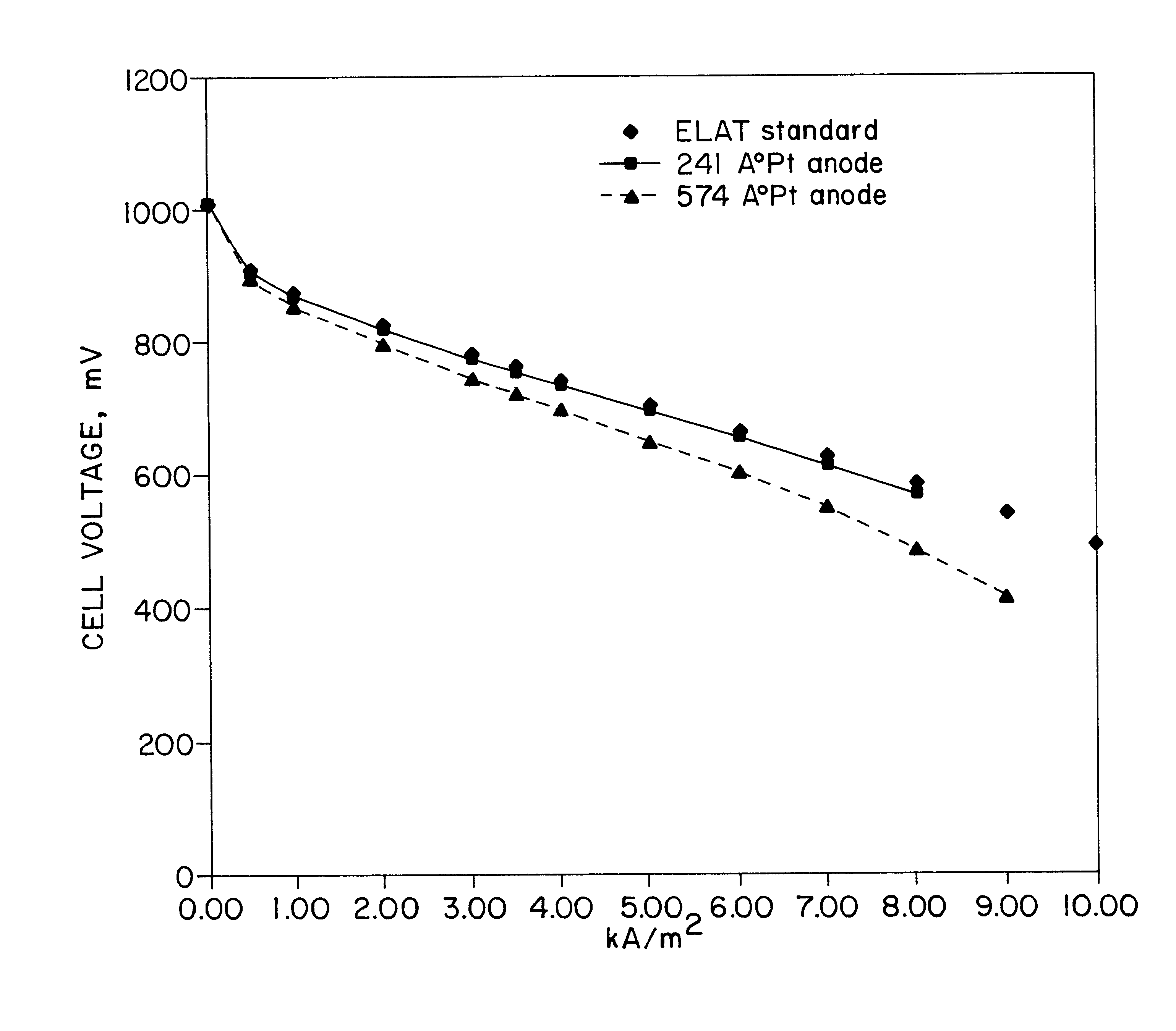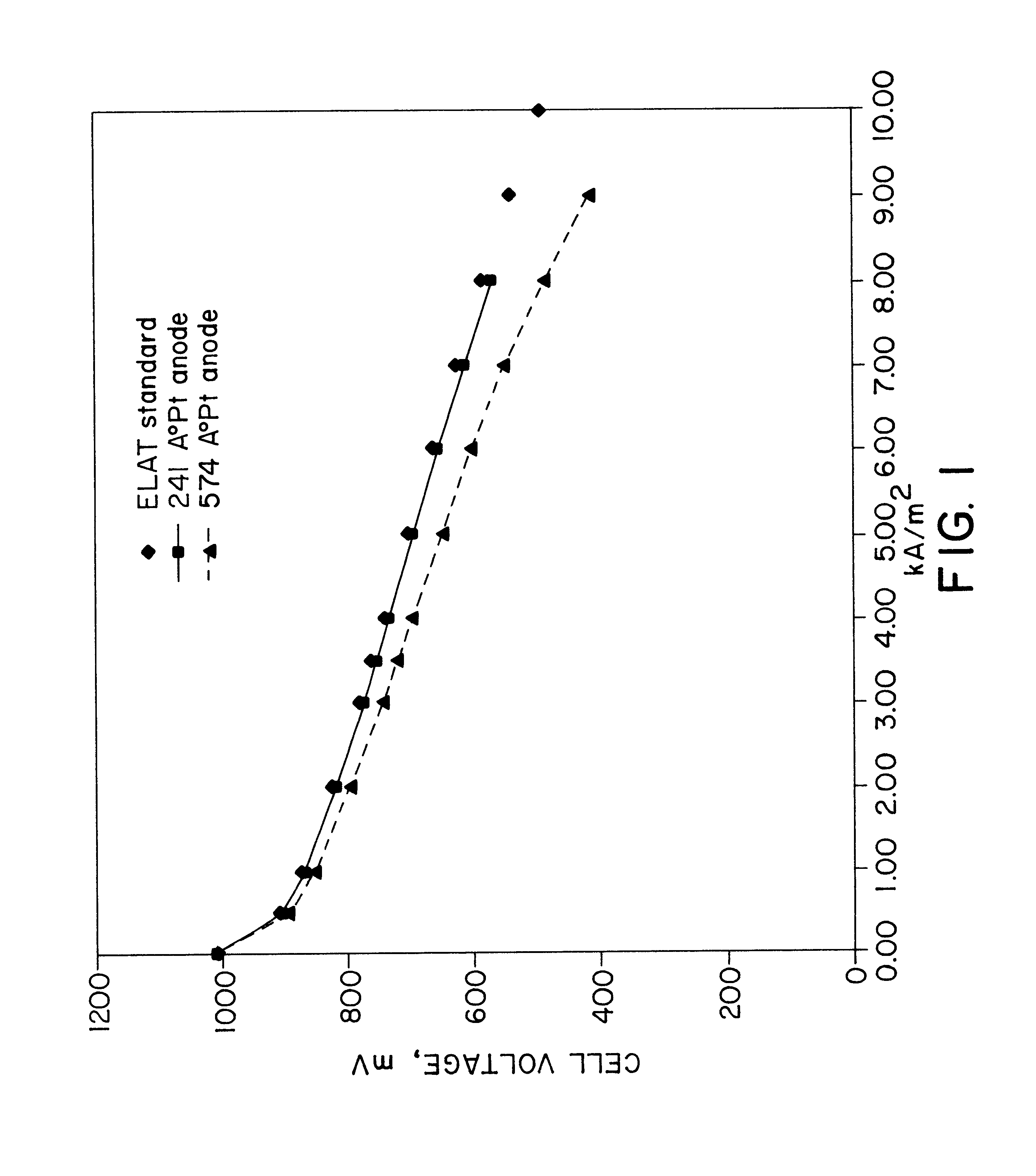Method of forming robust metal, metal oxide, and metal alloy layers on ion-conductive polymer membranes
a polymer membrane and metal alloy technology, applied in the field of electrochemistry, can solve the problems of difficult control of precipitation, limited effect of mechanical method for intimate contact of electrodes with polymer membrane electrolyte, and limited effect of direct deposit of thin electrode layers on ion-conducting polymer substrates
- Summary
- Abstract
- Description
- Claims
- Application Information
AI Technical Summary
Problems solved by technology
Method used
Image
Examples
example i
The following example demonstrates the use of an IBAD-prepared gas diffusion electrode in a hydrogen / air (O.sub.2) fuel cell. A sample of Nafion 115 (8".times.8") is used as received except for wiping the surface clean with a soft tissue before placing it on a drum. The drum was rotated at 2.5 rpm throughout the process and the system was evacuated to 10.sup.-6 torr. The metal source target was platinum while argon was ionized in both the energy beams. The energy of the beams was between 200 and 1000 eV. A source of platinum was the target for an evaporation electron beam powered with a 14K watt supply. The incipient platinum film's progress was monitored via quartz crystallometer. The sample temperature was monitored and ranged from 35 to 65.degree. C. For this trial, one side of the Nafion was coated with platinum. Four samples were prepared whereby the average film thickness was 3000, 1000, 574, and 241 angstroms. The assemblies with 574 and 241 angstrom platinum films were judge...
example ii
This example demonstrates the use of IBAD--modified ion conducting membrane as a highly selective separator. The problem of methanol crossover in a direct methanol fuel cell (DMFC) can be alleviated if a thin, dense, and impervious film is created on an ion-exchange membrane whereby protons are selectively transported through the structure. Such an assembly thus allows methanol oxidation at the anode, migration of the resulting protons through the structure, and oxygen reduction at the cathode whereby the protons re-combine with the oxygen reduction production to form water.
Tungsten oxide is a known selective proton conductor. However, previously known methods to form thin, impervious films of this oxide on an ion conductive membrane have precluded its use in the DMFC, or other applications.
Thin films of tungsten trioxide were formed on 8".times.8" pieces of Nafion. As in the previous example, the Nafion was mounted on a drum after a simple tissue wiping. The drum was rotated from 2...
example iii
This example illustrates the advantages of IBAD-modified membranes as compared to conventional gas diffusion electrodes for electrolysis of anhydrous hydrogen chloride. The same is true for other gaseous species at a gas diffusion chloride-ion exchange membrane interface.
A first set of 6".times.6" samples of Nafion 115 was used as received from the manufacturer except for wiping the surface clean with a soft tissue and isopropyl alcohol before placing on a drum. The drum was rotated at 2.5 rpm throughout the process. The system was evacuated to 10-6 torr. The metal source target was ruthenium metal while argon was ionized in both the low and high energy beams. The energy of these beams was approximately 300-400 and 1000-1500 eV respectively. In addition to the source of ruthenium and argon ions, oxygen gas was fed to a plasma, and the ionized vapor was subsequently stripped of positive radicals via an extraction grid. These positive oxygen ions were focused along with the ionized ru...
PUM
| Property | Measurement | Unit |
|---|---|---|
| Energy | aaaaa | aaaaa |
| Energy | aaaaa | aaaaa |
| Energy | aaaaa | aaaaa |
Abstract
Description
Claims
Application Information
 Login to View More
Login to View More - R&D
- Intellectual Property
- Life Sciences
- Materials
- Tech Scout
- Unparalleled Data Quality
- Higher Quality Content
- 60% Fewer Hallucinations
Browse by: Latest US Patents, China's latest patents, Technical Efficacy Thesaurus, Application Domain, Technology Topic, Popular Technical Reports.
© 2025 PatSnap. All rights reserved.Legal|Privacy policy|Modern Slavery Act Transparency Statement|Sitemap|About US| Contact US: help@patsnap.com


